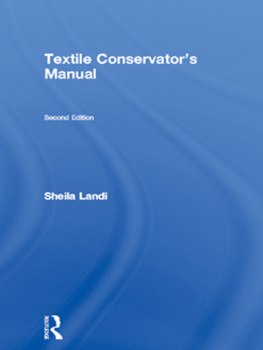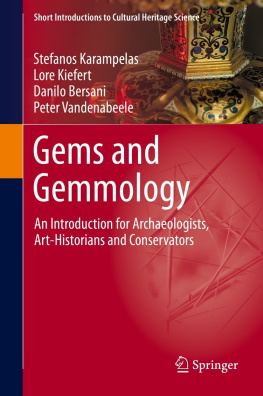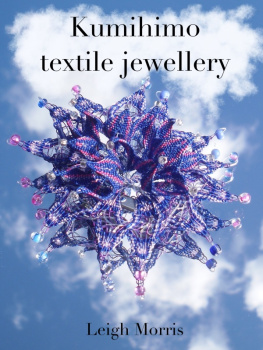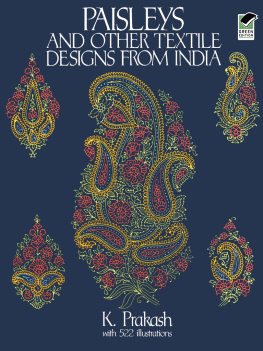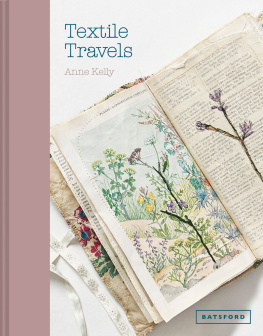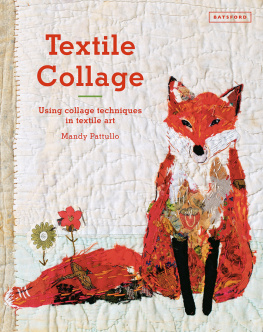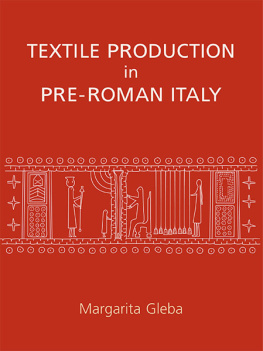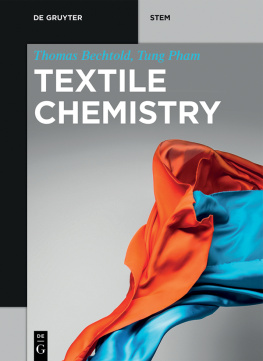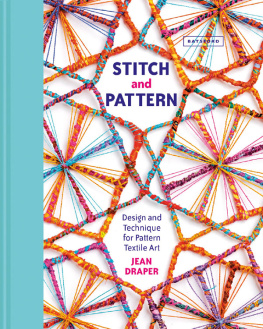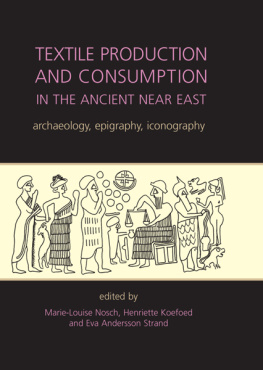Landi - Textile Conservators Manual
Here you can read online Landi - Textile Conservators Manual full text of the book (entire story) in english for free. Download pdf and epub, get meaning, cover and reviews about this ebook. year: 1998, publisher: Taylor and Francis, genre: Religion. Description of the work, (preface) as well as reviews are available. Best literature library LitArk.com created for fans of good reading and offers a wide selection of genres:
Romance novel
Science fiction
Adventure
Detective
Science
History
Home and family
Prose
Art
Politics
Computer
Non-fiction
Religion
Business
Children
Humor
Choose a favorite category and find really read worthwhile books. Enjoy immersion in the world of imagination, feel the emotions of the characters or learn something new for yourself, make an fascinating discovery.
Textile Conservators Manual: summary, description and annotation
We offer to read an annotation, description, summary or preface (depends on what the author of the book "Textile Conservators Manual" wrote himself). If you haven't found the necessary information about the book — write in the comments, we will try to find it.
Landi: author's other books
Who wrote Textile Conservators Manual? Find out the surname, the name of the author of the book and a list of all author's works by series.
Textile Conservators Manual — read online for free the complete book (whole text) full work
Below is the text of the book, divided by pages. System saving the place of the last page read, allows you to conveniently read the book "Textile Conservators Manual" online for free, without having to search again every time where you left off. Put a bookmark, and you can go to the page where you finished reading at any time.
Font size:
Interval:
Bookmark:

There are a number of people who have helped in the production of this second edition whose names must be added to those already mentioned when the book first appeared. I have used not only my own experience from working both inside and outside the museum world but also that of many of my colleagues, members of the staff of the Conservation Department of the Victoria and Albert Museum, as well as that of friends from other places, in order to record as broad a view of current practice and thinking as is possible in one publication. They know already how much I owe to them and that I cannot thank them enough for their patience and time.
. section 1.3 Science and Conservation . This new section was written by David Howell, scientist at the Hampton Court Palace Conservation Studios, who is one of the few scientists to take a specialist interest in the problems of textiles. He has also contributed the brief outlines of some of the techniques for testing and analysing materials which have been added in the appropriate places.
. The first draft was based on notes produced by Jo Darrah for the students in the Conservation Department, Victoria and Albert Museum. My draft of section 2.4, Degradation, also made use of an article written for CISST by Francesco Pertegato. Subsequently Jane Hutchins then of the Textile Museum, Merrimack Valley, USA, completely revised and amplified my version, giving it its final form. For the second edition Dr Bill Cooke of the Department of Textiles, Manchester University was good enough to check the text for inaccuracies and provide the information for section 2.5.
. In the early stages Judith Dore and Kysinia Marko each produced copious notes on which the first draft of this chapter in particular was based. It has now been expanded with much extra personal observation.
. I am no scientist and thus this chapter owes much to Ann Moncrieff in the beginning and subsequently to Stephen Rees-Jones. I am also indebted to Judith Hofenk de Graaf of Amsterdam for permission to quote from her work. I am grateful to Leslie Melville Smith for permission to use her work on the nature and use of enzymes in conservation.
. The list of materials and equipment was prepared and revised by Nicola Gentle. For this edition she revised the list yet again and added many new items.
Special mention must be made of Kysinia Marko who not only produced most of the rough sketches on which the diagrams for the category C (tapestries, rugs and carpets) heading in each chapter is based on the work she did while she was a member of the Victoria and Albert Museum staff. We have since discussed the necessity of making changes but most of that text remains the same.
. Maggie Dobbie, ex Senior Conservator in the Textile Conservation Section, Victoria and Albert Museum, now a private conservator, was my collaborator in the work on the counterpoint described in section 12.1. She wrote up the notes for our departmental records upon which I relied to refresh my memory of the hours we spent together, searching and speculating on our discoveries. She was also responsible for the work on which section 12.3 is based.
The work on the State Bed from Burghley House, Stamford, section 12.4, was coordinated by Eugene Shortall of Parke Interiors, London. The work on the wooden sections of the bed was carried out by Mr Charles Wright, late of the Furniture Conservation Section of the Victoria and Albert Museum, and his assistant. Miss Anne Van De Bergh, who is now employed by the National Trust, helped me with the textile part of the job.
I was indebted to Nicola Yates, conservator at the National Maritime Museum, who spent the relevant months gaining work experience with me, and Rosanna Rosicarella from the Instituto Centrale di Restauro, Rome, for help with the completion, on time, of the Juxon Chair, section 13.6.
Sarah White, currently a member of staff in the Textile Conservation Section, Victoria and Albert Museum but previously the backbone of the Osterley Outside Work Scheme, carried out the work described in section 13.7.
Nicola Gentle devised the method of working described in section 13.8.1 and Gill Owens carried out the difficult task presented by sections 13.8.513.8.8, both of the Textile Conservation Section, Victoria and Albert Museum. Nicola was also largely responsible for the support of the Stoke Edith embroidery, section 14.5.
Gill Owens worked for many years on the Warner Pattern Books, section 15.1, as a freelance conservator, before joining the staff.
I accompanied Francesco Pertegato, private conservator, Milano, to help as I could on the occasion described in section 15.12.
Jenny Band, head of the Textile Conservation Studios, Hampton Court Palace, wrote up the dreadful experience of the fire there for section 16.1.
Anna Kolata, who was the textile conservator of the Chicago Historical Society at the time, provided the account of the flood found in section 16.2.
The account of the flood at Osterley Park stable block, section 16.3, was provided by Nicola Gentle, who was the first conservator on the scene, augmented by my own memories.
Finally, I must say a public thank you to my husband for his long-suffering support and help during the production of this second edition.
My thanks are due to Dr Jonathan Ashley-Smith for permission to publish, and to Stephen Rees-Jones, the original series editor who also read the first draft of this edition, from whom I learnt a great deal.
Sheila Landi, july 1991
| IIC | International Institute for Conservation of Historic and Artist Works of Art, 6 Buckingham Street, London WC2N 6BA |
| SIC | Studies in Conservation (Journal of IIC) |
| ICCROM | International Centre for the Study of the Preservation and Restoration of Cultural Property, 13 Via di San Michele, 00153 Rome |
| CISST | Centro Italiano per lo Studio della Storia del Tessuto |
| GCI | Getty Conservation Insitute |
| UKIC | United Kingdom Institute for Conservaation, 37 Upper Addison Gardens, London W14 8AJ |
| SSCR | Scottish Society for Conservation and Restoration |
| CCI | Canadian Conservation Institute, 1030 Innes Road, Ottawa, Ontario, Canada K1A 0C8 |
| JAIC | Journal of the American Institute for Conservation |
| WIRA | Wool International Research Association |
List of photographs belonging to the Victoria and Albert Museum
All except 7.1 and 9.12
All
12.1, 2, 3, 4, 5, 6(a) & (b), 7, 16, 17a & b
13.1, 2, 3, 5, 6, 7, 8, 9, 10, 11, 12, 14, 15, 16, 17, 18, 19. 20, 21, 22, 23, 24, 25, 26, 27, 28, 29, 30, 31, 32, 33, 34, 35, 36, 37, 38, 39, 42, 43, 44
14.110 Ardabil carpet
14.11, 12, 13, 14, 15, 16, 18, 19, 20, 21, 22, 23, 24, 25, 26, 27, 28, 29, 30, 33, 34, 36, 37, 38
15.1, 2, 3, 4, 5, 6, 10, 11, 12
I have been heard to say that if a person gives as a reason for wanting to be a conservator, I just love beautiful old things, they are automatically rejected. That may be an exaggeration of my reaction but the phrase does carry with it an unfortunately romantic view of the past, its products and our relationship with them. In fact many museum textiles are neither particularly beautiful nor even old, their interest lying in other directions, and many conservation operations are dirty and repetitive. Excitement lies in discovery and the end product, the time in between being often rather boring; but beware of the idea that one can therefore think of other things while employed on apparently routine tasks. What is required is the ability to keep the end in view and sustain accuracy of hand and eye over a long period, after the first act of imagination and the interest of working out the solution has faded.
Font size:
Interval:
Bookmark:
Similar books «Textile Conservators Manual»
Look at similar books to Textile Conservators Manual. We have selected literature similar in name and meaning in the hope of providing readers with more options to find new, interesting, not yet read works.
Discussion, reviews of the book Textile Conservators Manual and just readers' own opinions. Leave your comments, write what you think about the work, its meaning or the main characters. Specify what exactly you liked and what you didn't like, and why you think so.

